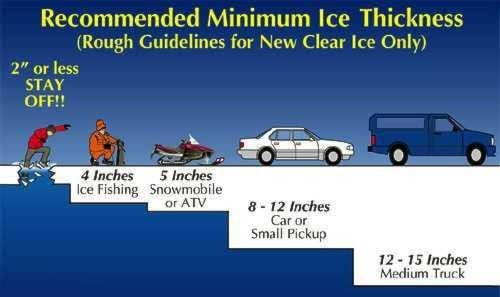The frozen, frigid temperatures have kept many Albertans huddled indoors, but others look at the thermometer with excitement, as the low temperatures mean lakes, creeks and rivers are going to freeze up.
Even with the cold temperatures, though, it may be too early to get out on the ice.
There are many factors that can affect the quality and thickness of ice, according to the Canadian Red Cross. Some of those factors include the water depth and the size of the body of water, currents and other moving water, water salinity, fluctuations in water levels, underwater hazards like logs and rocks, changing air temperatures and shock waves from vehicles travelling on the ice.
If out on ice, pay attention to the colour, as it can help determine at a glance whether or not ice is safe.
The Red Cross notes that clear, blue ice is the strongest, while white ice, also known as "snow ice,: is half as strong. Gray ice is absolutely unsafe.
What to do if you break throughIf you break through and find yourself in cold water, be prepared for the shock. The cold water will hurt, and can cause you to panic.
Instead of trying to scrabble out, the Red Cross suggests you try to get yourself into a floating position on your stomach. Then, using your legs, swim your way up onto the ice. Stay on your stomach, and crawl or roll away from the open area. Keep your arms and legs spread wide to help spread out your body weight.
Find somewhere warm immediately, get out of your wet clothes, and warm yourself gradually. Freezing water can numb, so be careful – you can burn yourself easily and not know it.
What to do if someone else breaks throughIf you are with someone and they break through the ice and into the water, or come across someone calling for help in the same situation, remember that the ice is thin where they are – that is why they are in the water.
If you can, phone 911 for assistance. If there are others around, see if they can help you, too.
A rescuer doesn't help anyone by needing to be rescued too, so consider whether or not you can safely help the person in the water. Use a long branch, a pole, a hockey stick or a rope to help the person out of the water.
If you have to go onto the ice, lay flat on the ice to spread out your body's weight, and inch forward slowly. Use a branch or rope, again, to get the person out of the water. Tell them to kick to help give them momentum as you pull.
The effects of cold water on the bodyA dousing in winter water is almost guaranteed to trigger hypothermia, which if left unchecked can be fatal.
When a person is dunked in cold water, or left exposed in cold temperatures, the body temperature begins to drop. It drops first in the arms and legs, and the victim will start shivering.
The body, in an effort to conserve heat, will circulate blood less to the outlying appendages, and the victim may begin to stumble, or have problems using their hands.
The organs like the heart and brain will drop gradually, but if left unchecked can result in unconsciousness, and eventual heart failure, according to the Red Cross.
Knowing the signs – uncontrollable shivering, lack of coordination, slowing down, numb hands and feet, an altered mental state, slurred speech and decreased attention span – can alert people to the severity of the hypothermia.
